Not much to show today. I spent a good deal of time working on some dice simulations/modeling. My goal was to think about how students might write a dice simulation in various languages and how one could facilitate understanding/learning about the underlying principles involved in dice simulation along with the concepts and ideas that can be explored in this process.
I looked at dice simulations in Scratch, TurtleArt and Python. I also explored ways I could create dice simulations in Etoys. As I mentioned in an earlier post I find "step by step" execution useful for not only teaching, but also for myself when the code doesn't do what I think it should.
I also played with various ways to write the simulation. Partly to think about how kids might do this. Side note - I found it really hard to overcome my pre-existing knowledge as I instantly went to more "advanced" ways of implementing simulations, rather than ways a novice might start out. I also tried various approaches to think about how to create some "good examples" that students can learn from.
These examples ideally would also show the evolution of my thought and try and convey that we don't start out with a thing of beauty but how refactoring and rethinking the problem can help improve your results (although admittedly I have on occasion wound up making things worse by over complicating ;)
Cheers,
Stephen
Post Script - Another way to think about simulations check this Scratch Studio - "Just like real life!" a more "real world" way kids think about simulations/modeling.

No comments:
Post a Comment